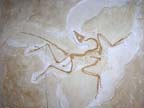 |
 |
 |
 |
 |
Produced
by the Population Genetics and Evolution class, Furman University |
||||
 |
 |
 |
 |
 |
Produced
by the Population Genetics and Evolution class, Furman University |
||||
 |
The
Neogene: Glyptodon |
 |
||
| Glyptodon,
commonly called the Giant Armadillo (Michaels and Fagan 1998), was a placental
mammal that was roughly the size of a Volkswagen Beetle. It is a member
of the order Xenarthra, which includes modern armadillos, anteaters, and
sloths (Wikipedia 2010). Glyptodon originated in South America,
although a related genus, Glyptotherium, lived in Central and
North America (Michaels and Fagan 1998). Glyptodon was thought
to be an herbivore that lived near water and ate plants that grew near
water (Wikipedia 2010). Its massive carapace consisted of over 1000 hexagonal
one-inch thick plates (Smithsonian Institute), called osteoderms or scutes
(Wikipedia 2010). To support its massive shell, it had fused vertebrae,
short but massive limbs, and a broad shoulder girdle. Since its head and
tail couldn’t withdraw into the shell, it had a ring of bones around
its tail and a bony cap on top of the skull. It also had deep lower jaws
with large chewing muscles to help it chew the fibrous plants it ate (Wikipedia
2010). Glyptodon had reduced nasal passages with large muscular
attachments. Although some people theorize that it might have had a truck
or probiscus like an elephant or tapir, its nasal bone do not recede back
on the skull like other animals with trunks. It is believed that humans
hunted them and may have used the shell as protection from bad weather
(Wikipedia 2010). Page by Laura Snyder |
 |
| Glyptodon. Photo From: Wikipedia | |
| Michaels GH, Fagan BM. 1998. The Ice Age 6; A Pleistocene Bestiary. University of California Santa Barbara. Accessed April 20, 2010. Wikipedia. 2010. Glyptodon. Accessed April 20, 2010. Smithsonian Institute. 2010.. The Megatherium--Megatherium cuvieri. Accessed April 20, 2010. |